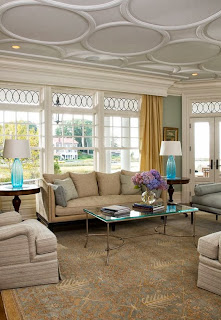Ceiling types are:
Flat (most common) Drywall and plaster construction.
Picture from http://www.houzz.com
Panel - Planks or panels are precisely cut, installed side-by-side and then stained or sealed to adorn flat or vaulted ceilings. They provide an elegant or cozy cottage feel;
Beamed - Exposed beams or joists, often in a dark finish to contrast with a white ceiling. They're arranged horizontally and generally intersect at various points. They provide a masculine or rustic elegance;
Picture from http://www.njestates.net/Resources/custom_homes
Coffered - Considered by some designers to be an "Old English" touch, these ceilings often are found in home libraries or studies. This architectural finish actually has its roots in the stone coffers of ancient Greece. In today's homes, coffered ceilings contain sunken panels, often squares or rectangles;
Cathedral - With tall, steeply pitched angles that meet symmetrically at an overhead crease, these ceilings take on the shape of a traditional church interior. They offer a dramatic, airy feel;
Picture from http://www.houzz.com
Cove - A gracefully curved arch that unites the ceiling and the upper walls and corners, eliminating sharp transitions and offering soft lines;
Drop - Also known as a false or suspended ceiling, a drop ceiling features a grid of thin metal channels filled with lightweight, 2-foot-wide tiles;
Tray - This ceiling has a recessed midsection that's higher than the perimeter, which provides a sense of spaciousness. This style has a clean, simple finish with an extra layer of crown molding. It can be dressed up with recessed lighting and other features;
Bulkhead - drops the ceiling down about a 12" or more but only in currant areas. Usually seen in kitchen above cabinets or like the below picture gives interest to the ceiling in this study;
Barrel Vault - also known as a tunnel vault or wagon vault, is commonly seen in home wine cellars, can be a very unique architectural feature. Think of the curved section you'd have if you cut a barrel vertically into sections - this resembles the curve of a barrel vault;
Groin Vault Ceiling - A groin vault or groined vault (also sometimes known as a double barrel vault or cross vault) is produced by the intersection at right angles of two barrel vaults.[
Picture from http://www.houzz.com
Shed - A shed ceiling has a flat surface that slants upward on one side. These ceilings are typically seen in Cape Cod-style homes with dormers or in homes where the attic has been extended to create additional living space
Dome - a rounded vault forming the roof of a building or structure, typically with a circular base.
Ceiling materials:
Drywall with plaster (smooth and/or textured) see Flat Ceiling picture for example
Popcorn ceiling - These lumpy off-white or gray ceilings were commonly sprayed on from the 1950s through the early 1980s., wood (planks and/or paneling);
Metal or Tin - metallic, ornate finish in the late 1880s. Traditionally, sheets of thin tin plates are stamped with a design and snugly meshed. Today, a faster way to achieve the tin look is to use a hand-painted finish or aluminum or plastic panels.;
Gold or Silver Leaf - can add interest
Moldings/Trims - Applied molding on the ceiling to add interest.
Tongue and Groove - Wood planking commonly used on walls can also add interest to a room’s ceiling.
Grass Cloth - commonly used on walls can add warmth to a room by adding it to the ceiling seen in powder rooms, bathrooms, and bedrooms.
Picture from http://glucksteinhome.tumblr.com/page/2
Brick - Rustic look used in French Country and Tucson style homes.
Tile (usually in showers)
Picture from http://www.houzz.com
Acoustical tile - Often utilitarian. These ceilings are typically covered with muted, light-colored square tiles. Of course, this ceiling feature isn't about "look" as much as it is about absorbing noise in a home theater, gym or office.
Keep in mind that patterns, dark or bright colors, textures, horizontal bands or beams, will lower the feel of the height of the room. Smooth surfaces or light, pale, or dull colors, angled ceilings with beams or band will visually lift the ceiling height.



















No comments:
Post a Comment